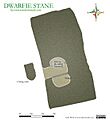Dwarfie Stane facts for kids
The Dwarfie Stane is a very old tomb carved right into a huge rock. This giant stone is made of Devonian Old Red Sandstone. You can find it in a deep valley on Hoy, an island in Orkney, Scotland. The stone was left there by a glacier long ago and sits in a lonely, peaty area.
This special stone is thought to be a tomb because it looks like other ancient tombs found in southern Europe. The Dwarfie Stane is the only chambered tomb in Orkney that was carved out of a single rock. Most other tombs are built from many stones. It might even be the only Neolithic (New Stone Age) rock-cut tomb in all of Britain!
Even though it's carved differently, the way the tomb is laid out inside is similar to other "Orkney-Cromarty" tombs found around Orkney. Some people call these "Bookan-class" tombs, named after another tomb on Mainland.
Contents
Entrance and Design
A stone slab used to block the entrance to the tomb on its west side. Now, this slab lies on the ground in front of it. This type of rock-cut tomb is very unusual for northern Europe. It's more like tombs from the Neolithic or Bronze Age found near the Mediterranean Sea.
Some experts think the idea of a rock-cut tomb was brought here but didn't work out well. Maybe it was too hard to carve the "extremely compact" Old Red Sandstone. However, there's no direct proof that the people who built this tomb were connected to those who made rock-cut tombs in the Mediterranean Sea.
Size and Inside the Tomb
The Dwarfie Stane is about 8.6 meters (28 feet) long, 4 meters (13 feet) wide, and up to 2.5 meters (8 feet) high. The entrance is a 1-meter (3-foot) square hole cut into the west side of the rock.
Inside, there's a passage about 2.2 meters (7 feet) long. On each side of the passage, there are two smaller rooms, called side cells. Each cell is about 1.7 meters (5.5 feet) long and 1 meter (3 feet) wide. Both the passage and the side cells are about 1 meter (3 feet) high. In the right, southern cell, there's a part of the rock that was left uncut, which looks like a "pillow."
History and Damage
At some point, the tomb was broken into through its roof. We don't know exactly when this happened, but people noticed the hole in the roof by the 1500s. The hole was fixed with concrete in the 1950s or 1960s to protect the tomb.
Legends and Visitors
The name "Dwarfie Stane" comes from a local story that a dwarf named Trollid lived there. It's funny because some people also claimed giants built it! The tomb became famous after Walter Scott wrote about it in his novel The Pirate in 1821.
You can see old graffiti on the rock-cut tomb from the 1700s and 1800s. One interesting message is in Persian writing. It says, "I have sat two nights and so learnt patience." This was left by Captain William Mounsey, who camped there in 1850. Above the Persian writing, you can see Mounsey's name written backward in Latin.
Today, Historic Environment Scotland looks after the Dwarfie Stane.
Images for kids


